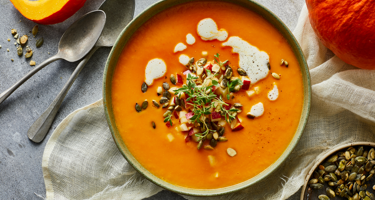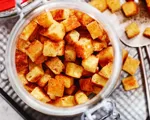
Red kuri squash has earned a place in kitchens for its delicate sweetness and rich, nutty taste. From comforting soups to elegant baked dishes, this winter squash brings warmth and colour to seasonal cooking. If you have spotted its bright red-orange skin at the market and wondered what to do with it, this guide will cover everything there is to know about it. You will learn when it is in season, how to cook and store it, and how it compares to the popular butternut squash.
What is red kuri squash?
Red kuri squash (also called Hokkaido or Uchiki Kuri) is a small to medium winter squash shaped like a teardrop. It has vibrant reddish-orange skin and firm golden-yellow flesh. It belongs to the species Cucurbita maxima, which is in the same family as Hubbard squash.
Unlike large carving pumpkins, this type is grown for its flavour, which is mildly sweet with a distinct nutty tone. When cooked, the texture is smooth and slightly starchy. One of its best qualities is the thin skin, which softens during roasting and becomes edible, so there is no need to peel it.
When is red kuri squash in season?
Red kuri squash is in season from late August through autumn, with its peak between September and November. It is harvested when the skin is hard and deeply coloured, and the stem looks dry and woody. While it is a cool-season crop grown in summer, it often stays available into early winter, making it perfect for cosy, cold-weather cooking well beyond Halloween.
What is the origin of red kuri squash?
The origin of red kuri squash is said to have begun in Japan in the early 20th century. It originated on the northern island of Hokkaido, where plant breeders took inspiration from the American Hubbard squash, introduced to Japan in 1878. By refining it into a smaller, thinner-skinned variety with a rich, nutty flavour, they created what we now know as red kuri.
Although all squash varieties trace their roots back to Mesoamerica, this particular type is distinctly Japanese in both its name and the way it has been refined over time. The word kuri means "chestnut" in Japanese, a fitting description of its sweet, chestnut-like flesh. Today, red kuri squash is widely grown not only in Japan but also across Europe, North America, and other regions.
How to cook red kuri squash
You can cook red kuri squash in many different ways, from roasting and baking to blending into soups and purées. Below, we will show you various ways to cook and prepare it. You can also find more inspiration in our collection of
Roasting red kuri squash
Roasting is a more straightforward and flavourful way to prepare red kuri squash. When roasted, its natural sugars caramelise, intensifying its chestnut-like sweetness and creating a tender interior with crispy, golden edges. There is no need to peel the squash since its skin softens naturally in the oven.
Simply slice it into wedges or halves, scoop out the seeds, drizzle with oil, season with salt and pepper (and perhaps a bit of paprika or cinnamon), and roast at 180 °C for around 30–40 minutes. Roasted butternut squash is a great base for salads and grain bowls, or you can enjoy it on its own.
Air frying red kuri squash
Air frying the red kuri squash is a convenient and quick way to prepare it while still achieving that golden, roasted finish. Thanks to its high-speed circulation of hot air, you get caramelised edges and tender flesh with minimal oil. Simply cut the squash into evenly sized wedges or cubes (again, no need to peel), toss with a small amount of oil and your favourite seasonings, and cook at 180 °C for 12–18 minutes, shaking the basket halfway through.
Use for soups and purées
Red kuri squash is perfect for soups and purées because of its naturally smooth and creamy consistency. Once cooked, it blends easily into a velvety base without the need for straining. For a hearty soup, just sauté onion and garlic, add cubed red kuri squash and your choice of stock, and let it simmer until tender. Finish it off with cream, coconut milk, or a knob of butter. Spices like ginger, nutmeg, or cumin are commonly used seasonings alongside the vegetable. Want to give it a go? Our red kuri soup is a perfect place to start.
Try it stuffed and baked
Red kuri squash is just the right size and shape for stuffing. Its edible skin holds up beautifully in the oven. Simply slice off the top, scoop out the seeds, and fill it with cooked grains like quinoa or bulgur, sautéed vegetables, herbs, and cheese. Bake until the squash is tender and the filling is golden and bubbling. For inspiration, see our stuffed butternut squash.
Bake it into something sweet
Thanks to its sweetness, red kuri squash is wonderful for cakes, muffins, and even homemade jams. Roast or steam it, then blend it into a smooth purée before adding it to your favourite recipes. Or skip the purée and grate it straight into the batter, like in
Preparing red kuri squash seeds
Do not toss those red kuri seeds because they make a great crunchy snack. They are easy to prep, too. Simply follow our step-by-step guide below on how to roast them:
Scoop out the seeds and separate them from the pulp.
Rinse thoroughly, then dry with a clean towel.
Toss with some oil, salt, and spices like paprika or cumin.
Roast on a baking sheet in the oven at 175 °C for 10–15 minutes, stirring once or twice.
Cool before eating. Store in an airtight container for up to a week.
How to store red kuri squash
Red kuri squash keeps well if you store it right, making it a convenient ingredient to keep on hand during the colder months. Whether whole or cut, the right storage will extend its shelf life and helps preserve its sweet, nutty flavour and firm texture.
Whole: Keep it in a cool, dry, and well-ventilated space. Ideal storage conditions are between 10–15 °C away from dampness, direct sunlight, or sources of frost, which can cause premature spoilage. Under the right conditions, red kuri squash typically keeps fresh for 2–3 months after harvest. Avoid stacking them directly on top of each other. Instead, place them in a single layer, ideally on cardboard, wooden slats, or shelves that allow air circulation. Store with the stem facing down to prevent moisture from entering and to reduce the chance of rot at the top.
Cut: Cut red kuri squash becomes more perishable and must be refrigerated. Wrap any leftover pieces tightly in cling film or beeswax wrap, or place them in an airtight container. Store in the fridge and use within 3–5 days. You can also freeze it. Simply peel and dice the flesh, then place it in freezer-safe containers or bags for up to 3 months. If you prefer, you can blanch the cubes first to preserve colour and flavour, though raw freezing also works well.
Red kuri squash vs. butternut squash
Both red kuri and butternut squash are favourites for autumn cooking and are often used together in soups. Below is a chart showing how they differ in flavour and texture, among other things.
| Feature | Red Kuri squash | Butternut squash |
|---|---|---|
| Shape/Colour | Teardrop, bright red-orange, thin edible skin | Bell-shaped, beige skin, thicker peel |
| Texture | Smooth, slightly starchy, chesnut-like | Creamy, moist, slightly sweet |
| Flavour | Mild, nutty, sweet | Sweet, buttery, with a hint of nuttiness |
| Cooking | Roast, stew, stuff, bake (skin is edible) | Roast, mash, soups, pies (usually peeled) |
| Shelf life | 2-3 months | 2-3 months, sometimes longer |
Explore other types of pumpkins
Red kuri squash is just one of many delicious autumn vegetables out there. Each has its own charm and works best in different kinds of dishes. If you enjoyed learning about red kuri, why not explore others like spaghetti squash or the classic Halloween pumpkin? You can also read through our comprehensive article on everything you need to know about pumpkins, or browse our pumpkin dishes and butternut squash recipes for even more ideas.






















&format=webp)
&format=webp)

















